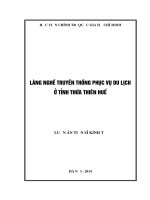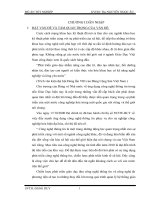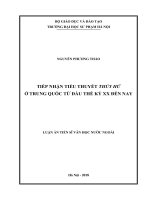Thiết kế chương trình tiếng Anh chuyên ngành cho trường Cao đẳng Công nghiệp Huế (Luận án tiến sĩ)
Bạn đang xem bản rút gọn của tài liệu. Xem và tải ngay bản đầy đủ của tài liệu tại đây (2.41 MB, 265 trang )
MINISTRY OF EDUCATION AND TRAINING
HUE UNIVERSITY
UNIVERSITY OF FOREIGN LANGUAGES
HỒ THỊ QUỲNH NHƯ
DESIGNING A VOCATIONAL ENGLISH CURRICULUM
FOR HUE INDUSTRIAL COLLEGE
DOCTOR OF PHILOSOPHY THESIS IN THEORY AND
METHODOLOGY OF ENGLISH LANGUAGE TEACHING
HUE, 2018
MINISTRY OF EDUCATION AND TRAINING
HUE UNIVERSITY
UNIVERSITY OF FOREIGN LANGUAGES
HỒ THỊ QUỲNH NHƯ
DESIGNING A VOCATIONAL ENGLISH CURRICULUM
FOR HUE INDUSTRIAL COLLEGE
DOCTOR OF PHILOSOPHY THESIS IN THEORY AND
METHODOLOGY OF ENGLISH LANGUAGE TEACHING
CODE: 62 14 01 11
SUPERVISORS:
TÔN NỮ NHƯ HƯƠNG, Ed.D.
TRƯƠNG BẠCH LÊ, Ed.D.
HUE, 2018
BỘ GIÁO DỤC VÀ ĐÀO TẠO
ĐẠI HỌC HUẾ
TRƯỜNG ĐẠI HỌC NGOẠI NGỮ
HỒ THỊ QUỲNH NHƯ
THIẾT KẾ CHƯƠNG TRÌNH
TIẾNG ANH CHUYÊN NGÀNH CHO
TRƯỜNG CAO ĐẲNG CÔNG NGHIỆP HUẾ
LUẬN ÁN TIẾN SĨ
LÝ LUẬN VÀ PHƯƠNG PHÁP DẠY HỌC BỘ MÔN TIẾNG ANH
HUẾ, NĂM 2018
BỘ GIÁO DỤC VÀ ĐÀO TẠO
ĐẠI HỌC HUẾ
TRƯỜNG ĐẠI HỌC NGOẠI NGỮ
HỒ THỊ QUỲNH NHƯ
THIẾT KẾ CHƯƠNG TRÌNH
TIẾNG ANH CHUYÊN NGÀNH CHO
TRƯỜNG CAO ĐẲNG CÔNG NGHIỆP HUẾ
LUẬN ÁN TIẾN SĨ
LÝ LUẬN VÀ PHƯƠNG PHÁP DẠY HỌC BỘ MÔN TIẾNG ANH
MÃ SỐ: 62 14 01 11
NGƯỜI HƯỚNG DẪN KHOA HỌC:
TS. TÔN NỮ NHƯ HƯƠNG
TS. TRƯƠNG BẠCH LÊ
HUẾ, NĂM 2018
STATEMENT OF ORIGINAL AUTHORSHIP
The work contained in this thesis has not been previously submitted to meet
requirements for an award at this or any other higher education institution. To the
best of my knowledge and belief, the thesis contains no material previously
published or written by another person except where due reference is made.
i
Signature:
_______________
Date:
28 September 2018
ACKNOWLEDGEMENTS
This study would not have been completed without the help and patience of many
people to whom I would like to express my sincere gratitude.
First of all, I feel deeply grateful to both of my supervisors – Dr Ton Nu Nhu
Huong and Dr Truong Bach Le – for their continuously kind supervision and warm
encouragement.
My gratitude also goes to the lecturers of Hue University of Foreign Languages:
Assoc. Prof. Dr. Tran Van Phuoc, Dr. Bao Kham, Assoc. Prof. Dr. Pham Thi Hong
Nhung, Assoc. Prof. Dr. Truong Vien, Assoc. Prof. Le Pham Hoai Huong and Dr.
Pham Hoa Hiep who have wholeheartedly encouraged and guided me through the
fulfillment of this thesis.
I also appreciate the enthusiastic cooperation from business administration
employees from the eleven corporations in Hue City for fulfilling the questionnaires
and attending the interviews.
I would like to express my thanks to the Rector Board of my college for granting
me study leave and for their participation in this study. I am also grateful to my
colleagues at the Department of Foreign Languages – Business Administration –
Tourism for supporting me and joining this study and taking up my workload while
I was conducting the research.
I wish to express my profound thanks to my parents, parents-in-laws and my two
little daughters who always give me great strength to overcome the tough and
challenging obstacles in study and in life.
Last but not least, I feel truly indebted to my husband who is always by my side
supporting me with unconditioned love and care.
ii
ABSTRACT
The central objective of this study was to develop a vocational English curriculum
for Hue Industrial College (HUEIC) in Vietnam. The development was based on
identifying the students‟ target needs and learning needs regarding English for
business administration (BuAdmin) and on analyzing the educational environment.
A combination of quantitative and qualitative approaches was adopted with the use
of multiple instruments: document study, placement testing (with 114 BuAdmin
students), questionnaires (delivered to students and BuAdmin employees), semistructured interviews (administered to 26 students, 8 employees, 3 employers, 7
ESP teachers, 5 content teachers and 3 college administrators) and curriculum
evaluation (HUEIC panel). The research methodology was constructed based on the
statement of the problem and the theoretical discussion of situation analysis and
needs assessment for the purpose of proposing an appropriate ESP curriculum. The
triangulation of data collection instruments, sources of information and various
investigated locations helped to increase the validity and reliability of the findings.
The data obtained were analyzed through SPSS statistics, content analysis and
triangulation. The findings informed factors that were important to both the
students‟ English learning and their target careers, which are: (i) all four English
language skills were perceived important but listening and speaking were more
needed at BuAdmin workplace; (ii) language skills for job purposes namely
telephoning, speaking and listening in social situations with business partners,
writing business letters and emails, reading business texts and job interviewing
should be prioritized in the new ESP curriculum; (iii) the course contents
recommended by the participants were marketing, sales/selling, finance, human
resources and production; and (iv) content-based and skill-integrated materials
should be used with the conduction of interactive activities during the ESP program.
Accordingly, the study proposed a new ESP curriculum for BuAdmin students. It
employed an integrated model of theme-based approach, skill-based approach and
communicative approach. The primary goals of this sample ESP curriculum were to
assist the students to achieve the expected EFL learning outcomes and to promote
the students‟ English knowledge and skills for BuAdmin job contexts. Through this
English learning program, the suggestions put forth by all the participants were
catered for.
iii
TABLE OF CONTENTS
STATEMENT OF ORIGINAL AUTHORSHIP
ACKNOWLEDGEMENTS
ABTRACT
LIST OF ABBREVIATIONS
LIST OF TABLES
LIST OF FIGURES
CHAPTER 1: INTRODUCTION ............................................................................... 1
1.1. Background .......................................................................................................... 1
1.2. Rationale .............................................................................................................. 3
1.3. Research objectives.............................................................................................. 5
1.4. Research questions ............................................................................................... 6
1.5. Scope of the study ................................................................................................ 7
1.6. Significance of the research ................................................................................. 7
1.7. Structure of the study ........................................................................................... 9
Chapter 2: LITERATURE REVIEW ....................................................................... 10
2.1. Introduction ........................................................................................................ 10
2.2. Language curriculum design .............................................................................. 10
2.2.1. Definition of the term curriculum................................................................... 10
2.2.2. Difference between syllabus and curriculum ................................................. 11
2.2.3. Model of language curriculum design ............................................................ 12
2.2.3.1. Environment analysis ............................................................................... 14
2.2.3.2. Needs analysis .......................................................................................... 14
2.2.3.3. Following principles ................................................................................. 15
2.2.3.4. Setting goals ............................................................................................. 16
2.2.3.5. Content and sequencing............................................................................ 17
2.2.3.6. Format and presentation ........................................................................... 17
2.2.3.7. Monitoring and assessing ......................................................................... 17
2.2.3.8. Evaluation ................................................................................................. 18
2.2.4. Curriculum approaches in language teaching ................................................. 19
2.2.4.1. Forward design ......................................................................................... 20
2.2.4.2. Central design ........................................................................................... 20
iv
2.2.4.3. Backward design ...................................................................................... 21
2.3. English for Specific Purposes (ESP) ................................................................. 22
2.3.1. ESP.................................................................................................................. 22
2.3.1.1. Development and definition of ESP ......................................................... 22
2.3.1.2. Characteristics of ESP .............................................................................. 24
2.3.1.3. ESP types .................................................................................................. 25
2.3.2. English for Business Purposes (EBP) ............................................................. 26
2.3.3. ESP and needs analysis ................................................................................... 29
2.3.4. ESP needs ....................................................................................................... 31
2.3.5. Approaches to ESP curriculum design ........................................................... 35
2.3.5.1. Language-centred approach ..................................................................... 35
2.3.5.2. Skills-centred aproach .............................................................................. 36
2.3.5.3. A learning-centred approach .................................................................... 37
2.3.6. Theory to language instruction ....................................................................... 37
2.3.6.1. Communicative approach ......................................................................... 37
2.3.6.2. Task-based approach ................................................................................ 39
2.3.6.3. Theme-based instruction .......................................................................... 40
2.4.The current English curriculum at HUEIC ......................................................... 47
2.5. Previous studies related to the current research ................................................. 49
2.6. Chapter summary ............................................................................................... 52
Chapter 3: METHODOLOGY ................................................................................. 53
3.1. Introduction ........................................................................................................ 53
3.2. Research design ................................................................................................. 53
3.3. Data collection ................................................................................................... 55
3.3.1. Participants...................................................................................................... 60
3.3.1.1. Business administration students ............................................................. 61
3.3.1.2. Business administration employees ......................................................... 62
3.3.1.3. ESP teachers and content teachers ........................................................... 63
3.3.1.4. HUEIC administrators .............................................................................. 64
3.3.2. Instruments...................................................................................................... 65
3.3.2.1. Document study ........................................................................................ 65
3.3.2.2. Placement testing ...................................................................................... 66
3.3.2.3. Questionnaires .......................................................................................... 70
v
3.3.2.4. Interviews ................................................................................................. 74
3.3.2.5. Curriculum evaluation .............................................................................. 78
3.4. Data analysis ...................................................................................................... 79
3.5. Reliability and validity ...................................................................................... 81
3.6. The role of the researcher .................................................................................. 84
3.7. Ethical issues...................................................................................................... 85
3.8. Chapter summary ............................................................................................... 85
Chapter 4: FINDINGS AND DISCUSSION ............................................................ 86
4.1. Target needs analysis ......................................................................................... 86
4.1.1. Employers‟ expectations of their employees‟ English competence ............... 86
4.1.2. Language requirements at work...................................................................... 88
4.1.3. Language skills for job contexts ..................................................................... 91
4.1.4. Frequency of English communicative activities ............................................. 94
4.1.5. Communicative topics at work ....................................................................... 96
4.1.6. Types of problems in English use encountered by BuAdmin employees ...... 98
4.1.7. BuAdmin employees‟ suggestions to students‟ English preparation ........... 100
4.2. The students‟ English learning needs analysis ................................................ 102
4.2.1. Students‟ purposes of learning English ........................................................ 102
4.2.2. Students‟ English proficiency ....................................................................... 104
4.2.3. Students‟ assessment of their English language competence ....................... 108
4.2.4. Students‟ accessibility to learning facilities ................................................. 111
4.2.5. Perceptions about English teaching and learning ......................................... 112
4.2.5.1. Students‟ perceptions of English courses at HUEIC .............................. 112
4.2.5.2. Students‟ perceptions of language skills needed for communication .... 114
4.2.5.3. The frequency of communicative activities conducted in English ........ 117
4.2.5.4. Preference for ESP materials .................................................................. 119
4.2.5.5. Preference for learning approach ........................................................... 121
4.3. The development of a new vocational English curriculum for HUEIC .......... 125
4.3.1. The sample vocational English curriculum design ....................................... 125
4.3.1.1. Overview of the program ....................................................................... 126
4.3.1.2. Target students ....................................................................................... 129
4.3.1.3. ESP teachers ........................................................................................... 129
4.3.1.4. Physical environment and resources ...................................................... 129
vi
4.3.1.5. Approaches ............................................................................................. 129
4.3.1.6. Goals and objectives ............................................................................... 130
4.3.1.7. Knowledge and skills ............................................................................. 130
4.3.1.8. Course framework .................................................................................. 135
4.3.1.9. Teaching methodology ........................................................................... 141
4.3.1.10. Teaching materials ............................................................................... 142
4.3.1.11. Testing and assessment ........................................................................ 143
4.3.2. The evaluation of the sample ESP curriculum ............................................. 143
4.3.2.1. The alignment of the new curriculum to the identified needs ................ 143
4.3.2.2. The college‟s evaluation of the new curriculum .................................... 149
4.4. Chapter summary ............................................................................................. 150
CHAPTER 5: CONCLUSION AND IMPLICATIONS ........................................ 151
5.1. Introduction ...................................................................................................... 151
5.2. Summary of key findings ................................................................................. 151
5.3. Implications ..................................................................................................... 154
5.4. Contributions of the research ........................................................................... 156
5.4.1. Theoretical contributions .............................................................................. 156
5.4.2. Pedagogical contributions ............................................................................. 158
5.5. Limitations of the present study and directions for future studies .................. 160
THE AUTHOR‟S PUBLICATIONS ..................................................................... 161
REFERENCES ....................................................................................................... 162
APPENDICES ........................................................................................................................ i
Appendix A: QUICK PLACEMENT TEST .......................................................................... i
ANSWER KEYS TO THE QPT .......................................................................................... xi
MARKING KIT.................................................................................................................... xi
Appendix B: QUESTIONNAIRES ..................................................................................... xii
B1: QUESTIONNAIRE FOR BUSINESS ADMINISTRATION EMPLOYEES ............. xii
Appendix B2: QUESTIONNAIRE FOR STUDENTS .................................................... xviii
Appendix C: INTERVIEW SCHEDULES ...................................................................... xxvi
Appendix C1: INTERVIEW SCHEDULE WITH ESP TEACHERS .............................. xxvi
Appendix C2: INTERVIEW SCHEDULE WITH CONTENT TEACHERS ................. xxvii
Appendix C3: INTERVIEW SCHEDULE WITH ADMINISTRATORS ..................... xxviii
Appendix C4: INTERVIEW SCHEDULE WITH STUDENTS ...................................... xxix
vii
Appendix C5: INTERVIEW SCHEDULE WITH BUADMIN EMPLOYEES ............... xxx
Appendix C6: INTERVIEW SCHEDULE WITH EMPLOYERS .................................. xxxi
Appendix D: TRANSCRIPTS OF INTERVIEWS ......................................................... xxxii
Appendix D2: SAMPLE INTERVIEW WITH CONTENT TEACHERS ..................... xxxiv
Appendix D3: SAMPLE INTERVIEW WITH HUEIC ADMINISTRATORS ............ xxxvi
Appendix D4: SAMPLE INTERVIEW WITH STUDENTS ........................................ xxxvii
Appendix D5: SAMPLE INTERVIEW WITH COMPANY MANAGERS ................ xxxviii
Appendix D6: SAMPLE INTERVIEW WITH EMPLOYEES............................................ xl
Appendix E: STATISTICS ................................................................................................ xlii
Appendix E1: BuAdmin employee questionnaires............................................................. xlii
E1a: BuAdmin employees‟ demographic data ................................................................... xlii
E1b: Reliability Statistics of the BuAdmin employee questionnaires ................................ xlv
Appendix E2: BuAdmin student questionnaires ............................................................... xlix
E2a: Demographic data about the students........................................................................ xlix
E2b: Reliability Statistics of the BuAdmin student questionnaires ........................................ l
Appendix E3: Factor analysis results .................................................................................. liii
E3a. Questionnaires for BuAdmin employees..................................................................... liii
E3b. Questionnaires for BuAdmin students ......................................................................... lv
Appendix F: CURRICULUM EVALUATION FORM ...................................................... lxi
Appendix G: DECISION ON ASSESSING THE NEW CURRICULUM AND THE
PANEL‟S EVALUATION ................................................................................................ lxiii
viii
LIST OF ABREVIATIONS
Ad
Administrator
BuAdmin
Business Administration
CBI
Content-based Instruction
CEF/CEFR Common European Framework of Reference for Languages
CLT
Communicative Language Teaching
CNP
Communication Needs Processor
CO
Company
CT
Content teacher
EAP
English for Academic Purposes
EBP
English for Business Purposes
EE
Employee
EFL
English as a Foreign Language
ELT
English Language Teaching
EOP
English for Occupational Purposes
EPP
English for Professional Purposes
ESP
English for Specific Purposes
ET
ESP Teacher
EVP
English for Vocational Purposes
FL
Foreign Language
GE
General English
GIL/GIS
Guided independent learning/study
HUEIC
Hue Industrial College
L1
First Language
LCPP
Language and Communication Courses for Professional Purposes
LSA
Learning Situation Analysis
M
Manager
MOET
Ministry of Education and Training
MOTI
Ministry of Trade and Industry
NA
Needs Analysis
NNS
Non-native Speaker
ix
NS
Native Speaker
PSA
Present Situation Analysis
QPT
Quick Placement Test
SD
Standard Deviation
SL
Second Language
SPSS
Statistical Package for the Social Sciences
St
Student
TEFL
Teaching English as a Foreign Language
TESL
Teaching English as a Second Language
TSA
Target Situation Analysis
x
Luận án đủ ở file: Luận án full









